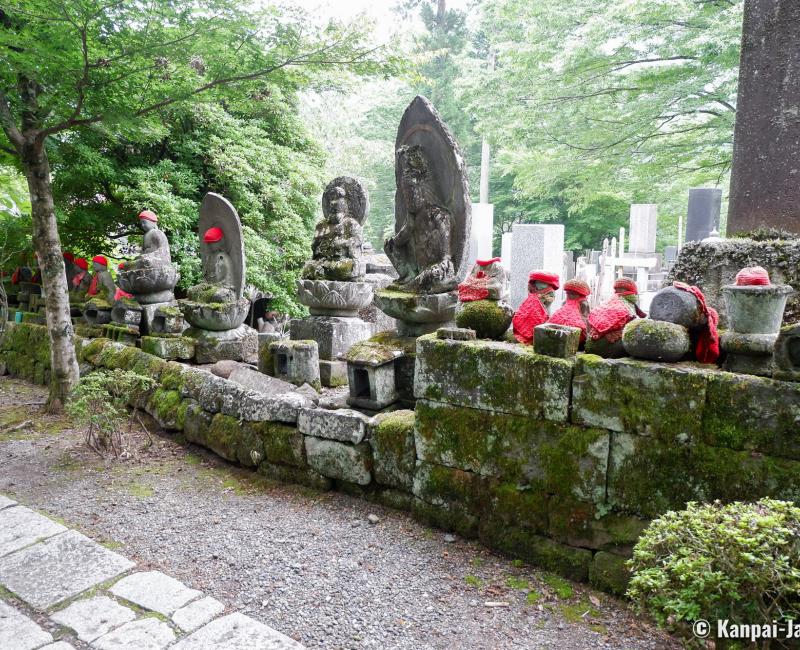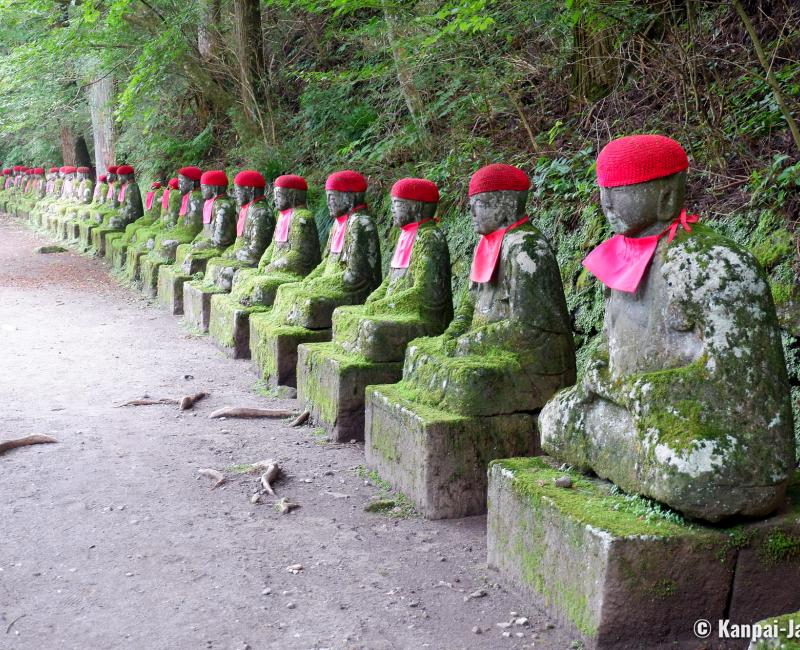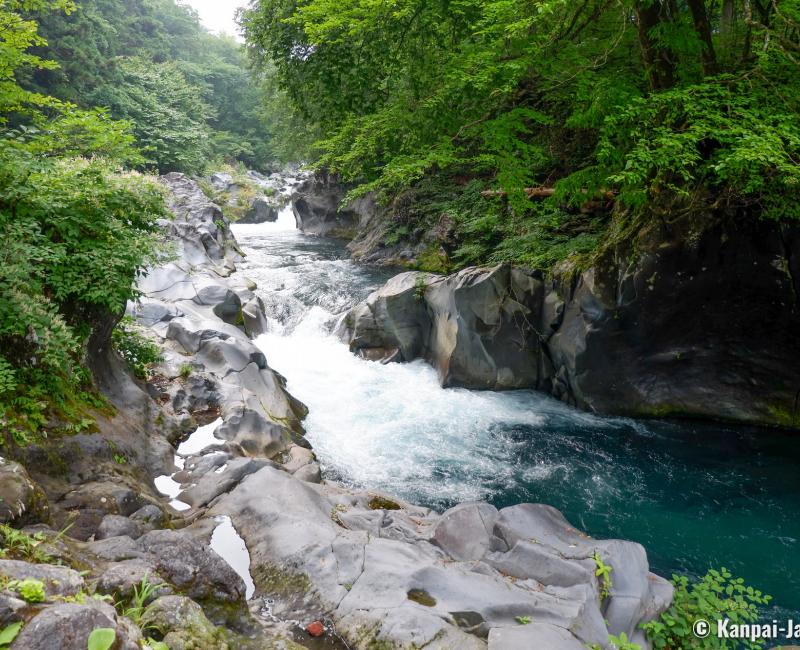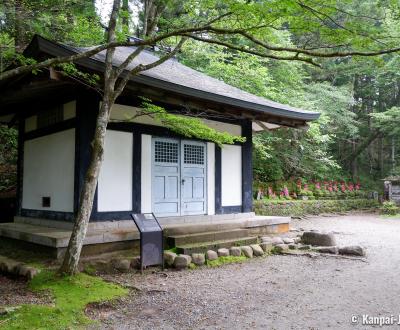Kanmangafuchi Abyss
The Mystical Line of Jizo Statues in Nikko
Kanmangafuchi Abyss is a several hundred meters long natural gorge along Daiya River, located in Nikko in the north-west of Tochigi prefecture. It is part of the historical Kanman Path and shelters Jiun-ji temple, famous for the Narabi Jizo, a single line of 74 statues. The visit is both pleasant and mysterious, offering a closer contact with the surrounding wilderness.
Nikko was initially a small mountain village in the north of Tokyo, but the historical significance it gained has turned it in an incredible destination for tourists. Millions of Japanese and foreign tourists are attracted each year in this city for good reasons: its shelters, among other things, the wonderful Tokugawa mausoleums, listed in the Unesco World Heritage List.
A stone’s throw away the places where most visitors gather, the historical Kanman path unfolds on about 5 kilometers: from the public building Nikko Sogo Kaikan to Tamozawa Imperial Villa, via Kanman-ga-fuchi gorge. In the heart of a wilder part of the site lie Buddhist artifacts that survived the great flood of Daiya River in 1902. Hundreds of stone statues of Jizo Bosatsu (the guardian of pilgrims and deceased children) are indeed standing, wearing their characteristic red crocheted cap and cloth bib.

Joko-ji: the temple at the entrance of Kanman-ga-fuchi gorge
Kanman path starts in a residential neighborhood, then reaches Joko-ji temple, whose origins date back to 1,200 years ago. Despite the modesty of its size and architecture, it shelters a few interesting relics that may draw history and spirituality amateurs, especially:
- Bonsho, the oldest bell in Nikko dating back to the middle of the 15th century,
- Kanman Oya Jizo On Kubi, the head of one of the two biggest Jizo statues that were formerly on the riverside,
- Sugegasa Higiri Jizo, a statue of Jizo wearing a bamboo hat (which is a quite rare feature) and enclosed in its altar. And,
- Michibiki Jizo, a small wooden pavilion opening on 3 Jizo statues, the oldest of which is said to date back to 1550. Michibiki means "the guide" and shows its role to accompany the deceased souls in Buddha’s paradise.
The path continues on a bridge crossing Daiya River, then through a forest clearing, and reaches the gate of Jiun-ji temple.

Jiun-ji: the temple of 74 Narabi Jizo statues
Jiun-ji temple was founded in 1654 by Kokai, a Buddhist monk of high rank and former disciple of master Tenkai (1536 - 1643). The original buildings were all washed away by 1902’s great flood and were replaced by one only small main hall Hondo, built in 1973.
Those who made Kanmangafuchi Abyss’ fame are standing here. Walking in the mild darkness of the surrounding forest in the gorge, on the side of the trail, facing the river, a row of 74 Jizo statues appears. It is called:
- Narabi Jizo (並び地蔵), that is to say "the line of Jizo"; or,
- Bake Jizo which means "the Jizo ghosts", as it is said impossible to count twice the same number of statues.
They were initially a hundred, all offered to the temple by Tenkai’s disciples. Some have disappeared due to the Rivers’s vagaries, like the couple Oya Jizo, that were large Jizo statues. Other sculptures are barely recognizable and only a couple of stones remain of them, with red cloth bibs on their base.
A little bit further is Reihikaku pavilion (霊 庇 閣), also a reconstruction. It was used for fire 🔥 rituals dedicated to Fudo Myo, one of the 5 Wisdom Kings, associated to fire and anger.
The atmosphere in the bottom of the abyss is heavy with mysticism, a feeling reinforced by the sound of the water streaming below and by the various faces of the Jizo statues that can be discerned underneath the moss. It makes an unforgettable experience.
However, it is strongly recommended not to tread too close to Daiya River. Its banks were formed by lava flows from an ancient eruption of Mount Nantai and they are very slippery and dangerous. The risk of falling is real especially for young children and the most fragile visitors. It is easy to imagine how such a green haven of peace can become a hostile and chaotic environment during heavy rainfalls.

To the end of Kanman path
The end of Kanman gorge overlaps the end of Jiun-ji temple’s precincts. it is time to go back, either by returning on the same path, or following on the historical route. When choosing the latter, cross Dainichi Bridge (大日橋) to walk back to the city by road 120, a frequented route with interesting highlights such as:
- A monument dedicated to a haiku written by poet Matsuo Basho (1644 - 1694) after his visit of Nikko in 1689,
- Junshi no Haka, a cemetery that shelters the tombs of 5 retainers, who committed suicide following the death of Tokugawa Iemitsu (1604 - 1651) and the tombs of 19 other who served the first two Tokugawa shoguns.
- Shaka-do, a small Buddhist temple dedicated to Shaka Nyorai, and,
- Tamozawa Imperial Villa Memorial Park, a large traditional construction built in 1899 for the prince who later became emperor Taisho.
Kanman Path is an easy walk, rather flat and without steep inclines or drops except for a few stairs. Its green sceneries and enchanting atmosphere offer a pleasant withdrawal from the tourists’ crowds. After closing the loop, the return to Nikko station can be made walking 3 kilometers for the most energetic, or by a short bus or taxi ride.

